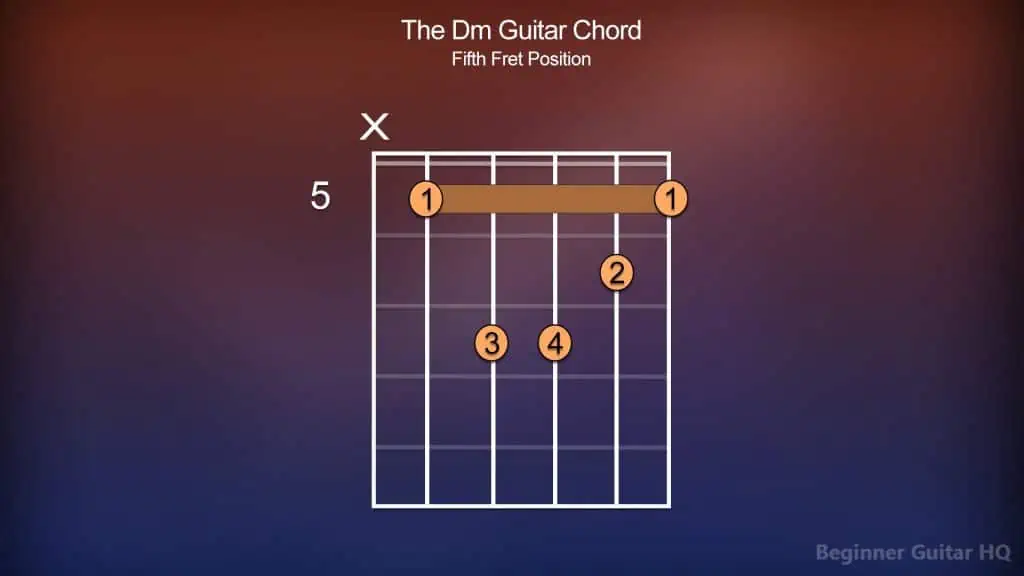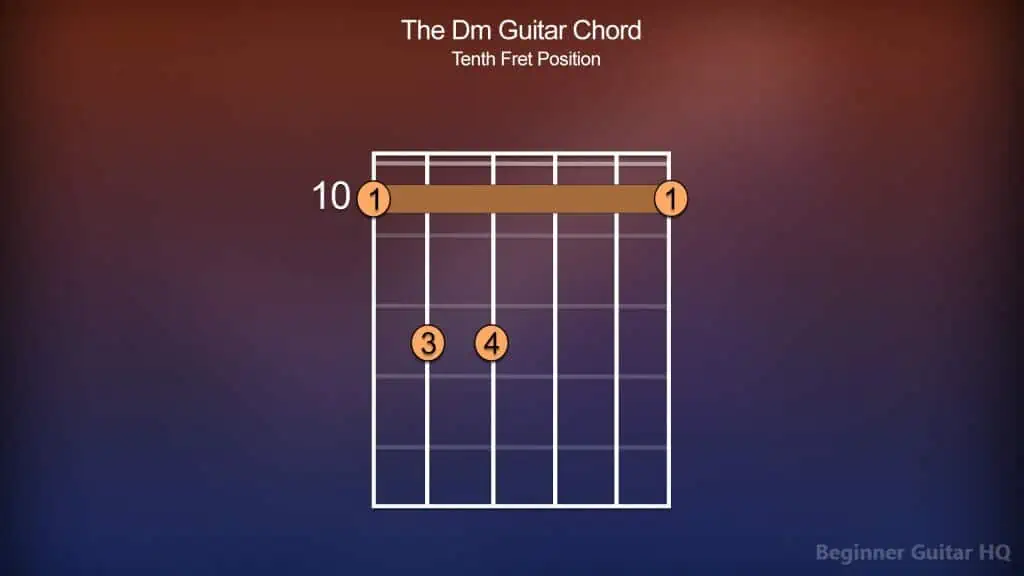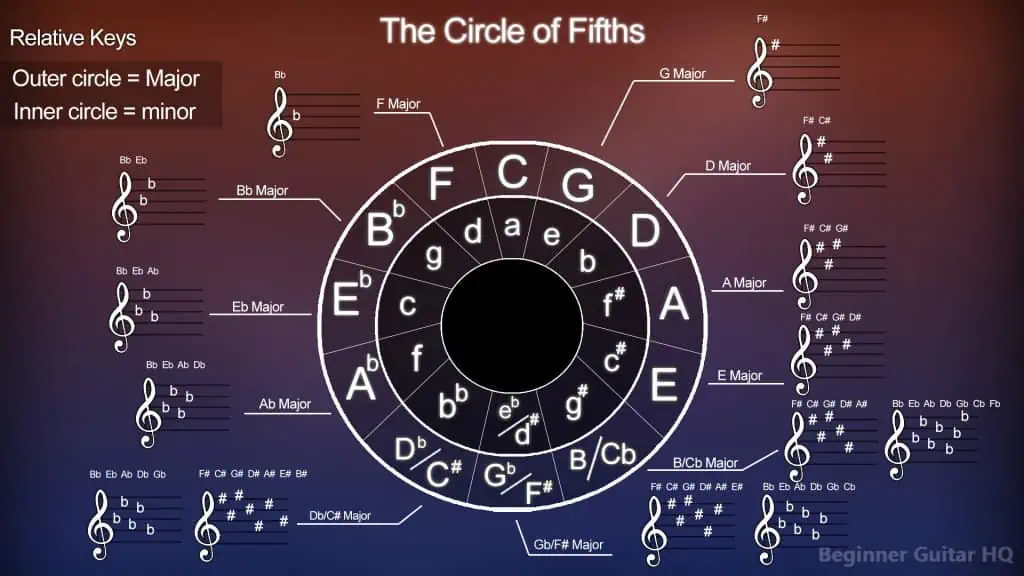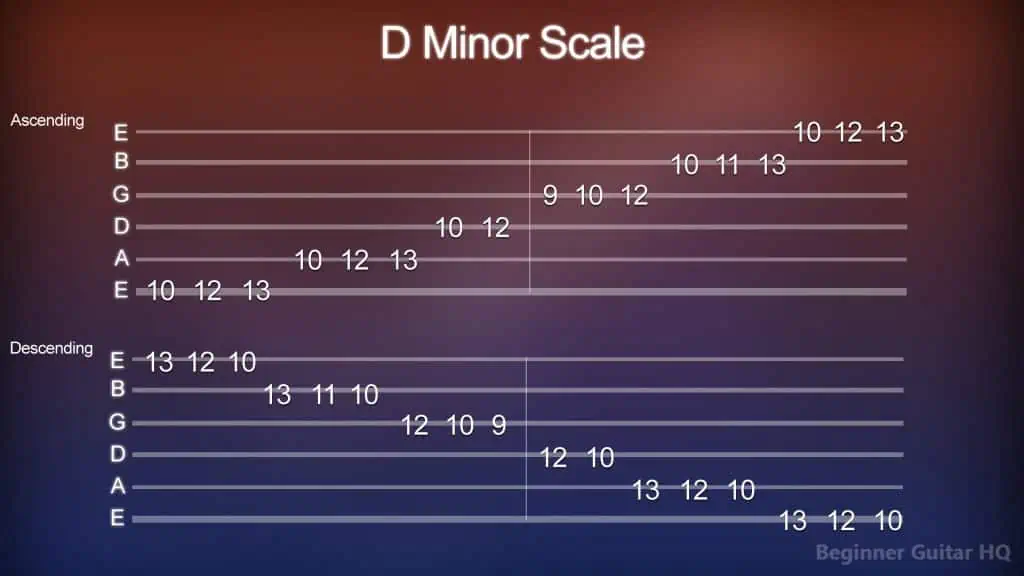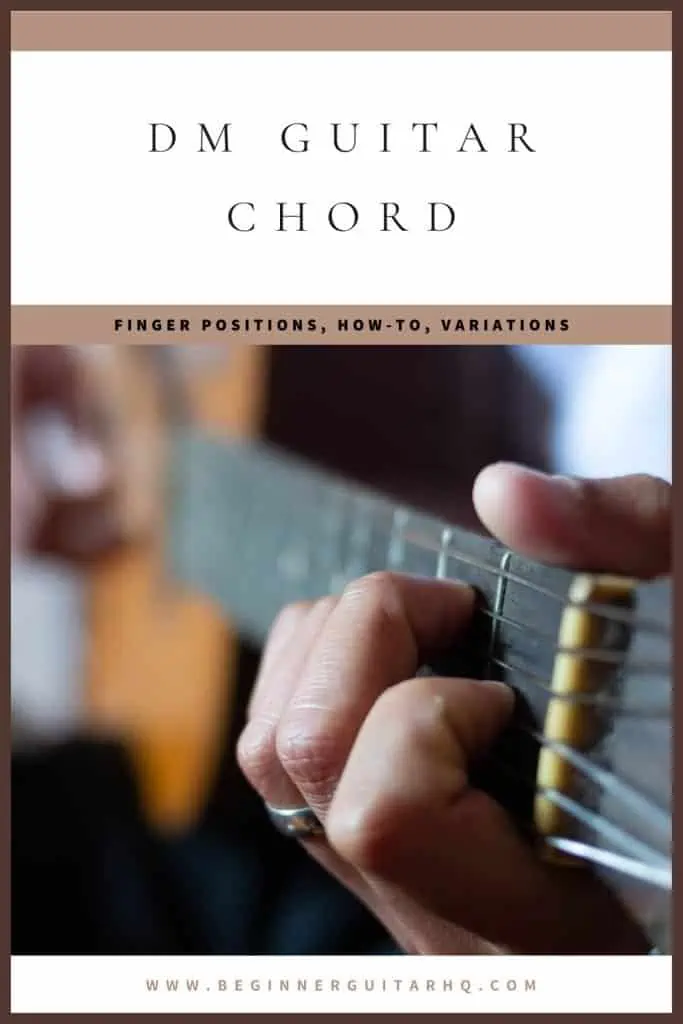Learning chords can be an excellent way of bolstering your skills on the guitar, as every musician pretty well uses them! In fact, as a beginner who is learning chords, it’s very likely that you’ve at least learned a little about different major guitar chords. However, what about what’s on the other side of the spectrum, our minor guitar chords, primarily, our Dm chord? As you read on, we’ll cover a bit about how to play this particular guitar chord, and more importantly, how it works! Let’s dive in!
Contents
How to Play the Dm Chord
If you already know how to play the cheerful D major guitar chord, it should come as no surprise that the Dm chord (D minor) is going to sound a bit sad. However, what may come as a surprise, is that many of our guitar chords have several variations. What is meant here is that our D major chord and our D minor chord can be played from several different positions on the fretboard!
Why play different variations of the same chord?
Firstly, you’ll want to play a variation of a chord that fits your playing ability. Many variations vary in difficulty, and if you’re just starting out with chords, you’ll probably want to play something that feels slightly more comfortable. Focusing on what you can play over what you can’t, will also improve your confidence on the guitar, and propel you forward. In due time, you may choose to up the ante, and try your hand at some barre chords. For now, however, just focus on what you can play.
Second, you will probably enjoy a variation that fits better into a specific chord progression, making it flow easier. While it technically is the same chord in a different place; if your chord progression is being played around the 2nd fret, why play a chord around the 8th fret? It might not make sense, however, it’s completely up to the musician!
Thirdly, it may come down to how it sounds. Yes, these chords are technically the same, however, different variations bring out different tones and colors. You may decide on a particular variation based on how it alters the feeling slightly before changing to another chord. As we know, chords are built off of triads, and within different variations, you may be doubling down on some of these notes within the triad producing a slightly different sound. It’s pretty cool!
Finally, it may simply come down to personal preference. We all have our favorite chords, based on any of the aforementioned factors. The important thing is to find what makes playing these chord progressions more enjoyable!
Without further ado, let’s try out our Dm guitar chord, and some of its variations:
Chord chart of the D minor guitar chord played from the open note position.
Chord chart of the D minor guitar chord played from the fifth fret position.
Chord chart of the D minor guitar chord played from the tenth fret position.
Trouble With Chord Charts?
If you’re new to chord charts, this might make you feel a little overwhelmed. That’s okay because many of us have been there before! In fact, learning chord charts is a very simple process and one that will serve you for years to come!
Let’s first bring our attention to the big rectangular box, housing our several vertical and horizontal lines; this represents our fretboard. Each of the six vertical lines represents a different string on the guitar. From the left to the right, we have our low E, A, D, G, B, and high E strings. The horizontal lines, however, are what separate one fret from the next.
Within the frets, and on top of the strings, you’ll see a circle containing a number anywhere from 1 – 4. These numbers help us identify which finger is supposed to go on the corresponding string to complete our guitar chord. The number 1 is for our index finger. The number 2 is for our middle finger. The number 3 is for our ring finger. Finally, the number 4 is for our pinky finger. If, however, you see a long dark bar stretching across several strings, along a single fret, this indicates you’re to form a “barre”. A barre is used to form our “barre chords”. To achieve this, you simply drape your index finger along a grouping of strings on a single fret and apply pressure.
On top of our fretboard, primarily the strings, you might notice an “O” or an “X”. If an “O” is present, this indicates that you’re to play an open note on that string to complete our chord (a string to be played but not fretted). If, however, there is an “X” present, that indicates you’re not to play that string to complete our chord. Finally, there may be a number present beside the fretboard. If a number is present, that indicates that you’re to begin forming the chord from that fret onwards. For example, if there’s a number 3, then the chord begins from the 3rd fret. If, however, there are no numbers present, then it’s generally implied that you’re playing the chord from the open note position.
That’s all there is to it!
Breakdown of the Dm Chord
The Dm chord, otherwise known as the D minor chord is used commonly across a wide spectrum of genres. Because of its simplicity, this makes it a great chord for beginners to learn, and add to their chord repertoire.
How does a chord like this work? To gain a deeper understanding of our Dm chord, it’s important we understand three fundamental things: the key, scale, and the triad.
Let’s begin with the key. The key can be thought of as a collective group of pitches, no different than what you’d find within a scale. What determines the pitches within the key? That’s where our key signature comes into play. Our key signature, visually represented by a collection of sharps (#) and flats (b), is often seen after the clef on a piece of sheet music. A note that is marked sharp is to be raised by a semitone. A note that is marked flat, however, is to be lowered by a semitone. How do we know which notes are supposed to be sharp or flat within a key signature? This is where it can help to consult the circle of fifths.
Diagram of the circle of fifths, showing the most commonly used keys.
The circle of fifths is a wheel-shaped diagram, displaying the most commonly used keys and their corresponding key signatures. Within the wheel, you’ll notice two rings. The inner ring houses all of our minor keys, while the outer ring contains all of our relative major keys (keys with a different root note, but contain the same key signature).
Starting from the middle of the wheel, a minor, going clockwise, you’ll notice that every key gains an additional sharp to its key signature. However, going counterclockwise, from a minor again, you’ll notice that each key gains an additional flat to its key signature. Looking at our circle of fifths, you’ll see that d minor falls under the left half of the wheel, so, therefore, we’ll be focusing on the keys containing flats. So, how are these flats determined within the key signature? We use a simple acronym: BEADGCF. This stands for:
“Battle, Ends, And, Down, Goes, Charles’, Father”
The first letter of each word within this saying represents a different note that’s to be made flat, following this sequence. In fact, let’s get a better look at how this sequence appears on the circle of fifths:
a = No sharps or flats.
d = Bb
g = Bb, Eb
c = Bb, Eb, Ab
f = Bb, Eb, Ab, Db
bb = Bb, Eb, Ab, Db, Gb
eb = Bb, Eb, Ab, Db, Gb, Cb
ab = Bb, Eb, Ab, Db, Gb, Cb, Fb
So, for instance, if we were in the key of C minor, knowing that it contains 3 flats, using our acronym (and our fingers!), we’d go, “Battle, Ends, And…” therefore, we know the flats within the key of C minor are: Bb, Eb, and Ab. Let’s try again, but with the key of Bb minor, containing 5 flats. Using our acronym, and fingers again, “Battle, Ends, And, Down, Goes…” therefore, the key signature of Bb minor is Bb, Eb, Ab, Db, and Gb. It’s very easy!
Knowing this method, we can determine that the key signature of D minor contains 1 flat, Bb. Now, let’s throw this all together and make our D minor scale:
D > E > F > G > A > Bb > C > D
Minor scales, like our D minor scale contain their own strict patterns of tones (T) and semitones (S):
T > S > T > T > S > T > T
We can observe our scale with this pattern and see that it follows it to a tee. Our first interval, D > E is a tone apart. Our second interval, however, E > F is a semitone apart. The third, and fourth intervals F > G, and G > A are both tones apart. In our fifth interval, B becomes Bb, shifting it a semitone closer to A, making A > Bb a semitone apart. Because of this change, in the sixth interval, Bb > C becomes a tone apart. Finally, in the seventh interval, C > D becomes a tone apart. It never fails!
Let’s try playing our D minor scale now:
Guitar tablature of the D minor scale, ascending and descending. Starting from the 10th fret.
Trouble With Tablature?
Guitar tablature, also known as “tab” is an excellent and efficient means for guitarists with no prior music theory knowledge to write, play and share some of their favorite songs and exercises. You may even choose to think of guitar tablature as a more simplified form of sheet music. While it might look somewhat complicated, it’s actually fairly straightforward and easy to learn!
Let’s first draw our attention to the six horizontal lines in front of you. Each of these lines represents a different string on the guitar. From the bottom to the top, we have our low E, A, D, G, B, and high E strings. On each string, you’ll notice a number, indicating the fret you’re to play on the corresponding string. So for instance, if you have the number 3 on the low E string, then you’re to play the third fret of the low E string. If you have the number 5 of the A string, then you’re to play the fifth fret of the A string. However, if you have the number 0 on any string, then you’re to play an open note on that corresponding string (a string to be played but not fretted). That’s all there is to it!
There are some great and immediate benefits with guitar tablature, allowing beginners to start learning the guitar right away. However, it’s important to note some of the drawbacks beginners need to be aware of. The first drawback is the amount of detail or lack thereof. The quality of guitar tablature often varies, especially when getting your tablature from the internet. Most often, the tablature you read will differ greatly from the overabundant quality of information supplied to you from sheet music. In fact, in this case, it’s up to you the guitarist to use your “musician’s ear” to fill in the gaps yourself, in how things are meant to be played. However, we say “most often”, and not 100% of the time. There are many well-known symbols used across tablature to help supply musicians this essential information:
H = Hammer-on
P = Pull-off
B = Bend
X = Mute
PM = Palm Mute
\ = Slide Down
/ = Slide Up
~~~ = Vibrato
The other important pitfall to be aware of doesn’t just apply to beginners reading tablature, but any self-taught guitarist; proper playing technique. More specifically, we mean proper fingerwork. When teaching yourself how to play the guitar, it can be incredibly easy to develop bad habits, ultimately leading to sloppy playing technique. While of course, there can be great tools to help you improve upon this; a metronome, spider exercises, recording yourself… etc. Fingerwork, and developing proper posture are surefire ways of improving upon this. It’s important that whatever you plan to play or practice, you read ahead and figure out where your hand would be best placed, and where your fingers should go. Most of the time, guitar tablature, let alone sheet music won’t supply you with this information, as it’s generally implied that you know, or can figure it out. However, in terms of “completely fixing” sloppy playing technique, this is only just the beginning.
Scale Degrees
Now that we’ve gone over the D minor scale, and how we can play it, let’s cover it in a little more depth. Did you know that each note within the D minor scale plays an important role? We call each of these notes our different scale degrees. Each of these different scale degrees has its own name that helps musicians refer back to them with ease. Using our D minor scale, let’s go over each of them:
D = Tonic (1st Degree)
E = Supertonic (2nd Degree)
F = Mediant (3rd Degree)
G = Subdominant (4th Degree)
A = Dominant (5th Degree)
Bb = Submediant (6th Degree)
C = Leading Tone (7th Degree)
D = Tonic (1st Degree/Octave)
Let’s cover each degree with a little bit more depth. Our first degree, the tonic, is our home and tonal center; things tend to resolve here. The second degree, the supertonic, acts as a predominant degree, sharing two notes in its triad with our fourth degree. The third degree, the mediant, shares two notes within its triad as our tonic, making this an excellent degree for drawing the tonic out. The fourth degree, the subdominant, holds some minor tension, naturally wanting to move to greater tension. The fifth degree, the dominant, is the most important degree, next to our tonic. This is the climax, the peak of our tension, where it’ll naturally want to resolve back home to our tonic. Next, we have the submediant, the sixth degree. Our submediant shares two notes with our subdominant triad, making it an excellent predominant degree for tension. Last, we have our leading tone, another very tense degree (important for building our 7th chords). In fact, try playing the C major scale and ending on B; your ears will want to hear it resolve back to C. Then moving up, we’re back home on the tonic, just an octave higher from where we began.
Triads
Now that we are familiar with our different scale degrees, we can now go over triads. A triad is a grouping of three notes played in unison. Minor triads, in particular, are built by taking the tonic, mediant, and dominant degrees (1st, 3rd, and 5th degrees) of the minor scale, and stacking them on top of each other. With the D minor scale, we get the notes: D, F, and A in our D minor triad.
When building a minor triad, there are some characteristic intervals that give our minor triad its melancholy sound:
- Minor 3rd – Between the 1st and 3rd degrees. D > F.
- Major 3rd – Between the 3rd and 5th degrees. F > A.
- Perfect 5th – Between the 1st and 5th degrees. D > A.
Finding Chords Compatible With D minor
Building chord progressions is a challenge that most musicians face at one time or another, let alone one we like! However, there’s a process to make this just a little easier! Let’s take what we know about triads, and stack one on each degree of our D minor scale:
D minor = D, F, A (Tonic/1st Degree)
E diminished = E, G, Bb (Supertonic/2nd Degree)
F Major = F, A, C (Mediant/3rd Degree)
G minor = G, Bb, D (Subdominant/4th Degree)
A minor = A, C, E (Dominant/5th Degree)
Bb Major = Bb, D, F (Submediant/6th Degree)
C Major = C, E, G (Leading Tone/7th Degree)
These are all of the compatible chords within the key of D minor. While this might be useful for knowing which chords go well together, you might still feel somewhat stuck on where to begin! In this case, it can help to look toward some tried and true chord progressions. Let’s cover a couple of these:
i – iv – v
The “one-four-five” chord progression is one of the most commonly used chord progressions out there! For this, we’ll be starting with the tonic, our D minor chord. This is our home and tonal center, where things feel relatively calm. Shifting to some mild tension, we’ll be playing our subdominant, the G minor chord. G minor shares one note in its chord with D minor, which happens to be D. Shifting to greater tension, we’re now on the dominant, A minor. This is the peak of our tension – A minor shares one note as well with D minor; A. We’ll naturally want to resolve, so, therefore, we’ll return home to our tonic, D minor to do it all again.
Our chord progression looks like this: Dm > Gm > Am
i – VI – VII
This three-chord progression is slightly different from the last one. We’ll begin yet again on the tonic, D minor. Moving from D minor, we’ll instead land on the submediant, Bb major. Now, remember, Bb major shares two notes with the subdominant, which makes this an excellent predominant chord for adding tension. Not only that, but it shares two notes with our tonic; D and F. Next, to shift to even greater tension, we’ll move to our leading tone, C major. C major, holding the greatest tension, sharing no notes with the tonic, or the submediant, will naturally want to resolve. Therefore, we’ll move back home to D minor, repeating the process.
Dm to Dmaj
We’ve covered quite a bit about our D minor chord, but what about its major counterpart, D major? Well, first we need to make a quick note of the parallel key relationship between Dm, and Dmaj. This means that while they share the same tonic, they have different key signatures. This differs from the relative key relationship that D minor has with F major, in which they have different tonics, but share the same key signature.
If you look towards the circle of fifths, you’ll notice that D major is on the right half of the wheel, where all of the keys with sharp key signatures are. So how do we identify the key signature of D major? We simply take the acronym from before; BEADGCF, and reverse it to FCGDAEB. This stands for:
“Father, Charles, Goes, Down, And, Ends, Battle”
You may use the exact same method as before with this version of the acronym. Doing so, you’ll see that the key of D major, contains 2 sharps none other than F#, and C#. Now, let’s throw this into the D major scale:
D > E > F# > G > A > B > C# > D
Major scales, just like our minor scales, have their own specific pattern of tones (T) and semitones (S) that they always follow:
T > T > S > T > T > T > S
As you can see, the first two intervals, D > E, and E > F# are both a tone apart. The third interval F# > G is a semitone apart. The next three intervals, G > A, A > B, and B > C# are all tones apart. Finally, C# > D is a semitone apart. It always checks out
Because of the different key signatures, the scale isn’t the only thing affected. Let’s take a look at our triad of D major. Major triads, no different than minor triads, consist of the same three degrees of the scale being used; tonic, mediant, and the dominant. This gives us the grouping of notes: D, F#, and A.
However, while the degrees being used within the triads remain the same, the intervals are slightly different within!
- Major 3rd – Between the 1st and 3rd degrees. D > F#.
- Minor 3rd – Between the 3rd and 5th degrees. F# > A.
- Perfect 5th – Between the 1st and 5th degrees. D > A.
Can you see the difference? It’s reversed! In a major triad, the 1st interval is a major 3rd, while in a minor triad it’s a minor 3rd. The 2nd interval, however, in a major triad is a minor 3rd, while in a minor triad it’s a major 3rd. The perfect 5th remains the same in both!
Let’s try playing a D major chord now:
Chord chart of the D major guitar chord played from the open note position.
Conclusion
There you have it! Now you have all of the tools you need to get started with the Dm chord. Minor chords are a really great way of conveying contrasting emotions within a song, telling more of a story. In fact, it’s highly recommended to learn other minor chords as well, to build up your chord repertoire, like your Am, Bm, Cm, Em, Fm, and Gm chords. Trying to understand what makes the chord sound the way it does can really help you discern the difference between major and minor chords. Furthermore, it can be one of the many different ways you choose to challenge yourself on the guitar, and take your skills to the next level!


